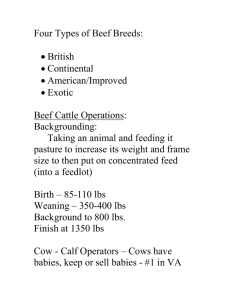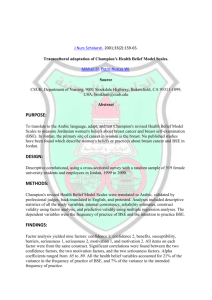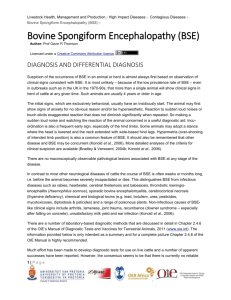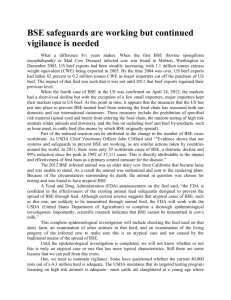TSEs in captive wild ruminants, cats, and monkeys in Europe are
advertisement
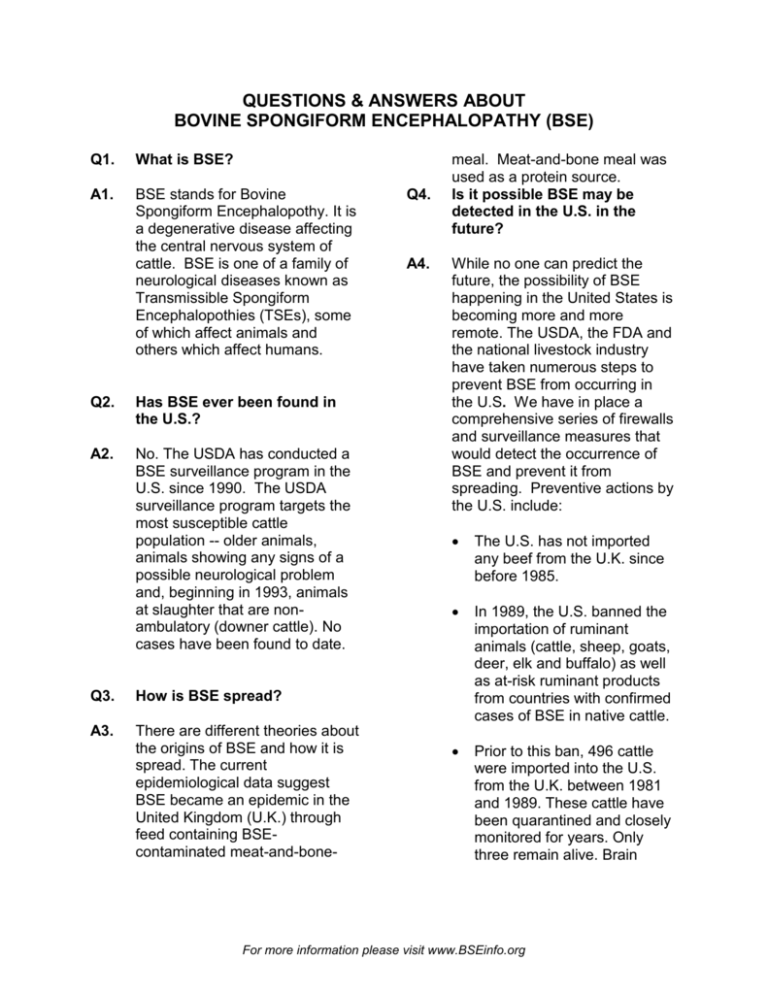
QUESTIONS & ANSWERS ABOUT BOVINE SPONGIFORM ENCEPHALOPATHY (BSE) Q1. What is BSE? A1. BSE stands for Bovine Spongiform Encephalopothy. It is a degenerative disease affecting the central nervous system of cattle. BSE is one of a family of neurological diseases known as Transmissible Spongiform Encephalopothies (TSEs), some of which affect animals and others which affect humans. Q2. Has BSE ever been found in the U.S.? A2. No. The USDA has conducted a BSE surveillance program in the U.S. since 1990. The USDA surveillance program targets the most susceptible cattle population -- older animals, animals showing any signs of a possible neurological problem and, beginning in 1993, animals at slaughter that are nonambulatory (downer cattle). No cases have been found to date. Q3. How is BSE spread? A3. There are different theories about the origins of BSE and how it is spread. The current epidemiological data suggest BSE became an epidemic in the United Kingdom (U.K.) through feed containing BSEcontaminated meat-and-bone- Q4. A4. meal. Meat-and-bone meal was used as a protein source. Is it possible BSE may be detected in the U.S. in the future? While no one can predict the future, the possibility of BSE happening in the United States is becoming more and more remote. The USDA, the FDA and the national livestock industry have taken numerous steps to prevent BSE from occurring in the U.S. We have in place a comprehensive series of firewalls and surveillance measures that would detect the occurrence of BSE and prevent it from spreading. Preventive actions by the U.S. include: The U.S. has not imported any beef from the U.K. since before 1985. In 1989, the U.S. banned the importation of ruminant animals (cattle, sheep, goats, deer, elk and buffalo) as well as at-risk ruminant products from countries with confirmed cases of BSE in native cattle. Prior to this ban, 496 cattle were imported into the U.S. from the U.K. between 1981 and 1989. These cattle have been quarantined and closely monitored for years. Only three remain alive. Brain For more information please visit www.BSEinfo.org tissue analysis of imported cattle showed no presence of any TSE, including BSE. In addition, only five cows imported from other countries in Europe in 1996 and 1997 remain alive, and they are under quarantine. Other imported European cattle were tested for BSE and were found to be negative. from spreading through cattle feed. 237 cattle from Japan were imported between 1993 and 1999. All were imported for breeding, and all have been traced. The U.S. stopped imports of live ruminants and ruminant products from Japan in March 2000 because of foot-and-mouth disease in that country. That ban was never lifted, and the import ban remains in effect because of that country’s discovery of BSE in three dairy cows in 2001. More than 60 veterinary diagnostic laboratories throughout the U.S. participate in a BSE surveillance program along with the National Veterinary Services Laboratory in Ames, Iowa. On August 4, 1997, an FDA regulation went into effect banning the use of at-risk mammal-derived animal protein by-products in cattle feed to ensure that if the BSE disease agent ever entered the U.S. it would be prevented On December 12, 1997, the USDA banned imports of all live ruminants and certain ruminant products from European countries until BSE is more fully understood. On April 24, 1998, the USDA entered into a cooperative agreement with Harvard University’s School of Public Health to analyze and evaluate the USDA’s BSE prevention measures. On December 7, 2000, the USDA prohibited all imports of rendered animal protein products from Europe, regardless of species. Q5. Is the USDA’s cattle surveillance program adequate enough to find BSE should a case ever occur? A5. Yes. We’re fully confident, having worked with USDA for more than a decade on this surveillance program. The United States was the first country in the world without the disease to establish a formal, science-based BSE surveillance program, which began in 1990. The USDA surveillance program targets the most susceptible cattle population -- older animals, animals showing any signs of a possible neurological problem and, beginning in 1993, animals For more information please visit BSEinfo.org 2 at slaughter that are nonambulatory (downer cattle). The ban on imports of live animals and on ruminant products that could carry the BSE agent has been the foundation of the U.S. disease prevention program. Cattle under 20 months of age make up nearly 90 percent of the U.S. slaughter population. Nowhere in the world has BSE been diagnosed in cattle less than 20 months of age. As we continued to monitor the BSE situation in Europe, planning for the feed ban began in 1996, and the FDA regulation became effective in 1997. Since 1994, the U.S. surveillance program has used the immunohistochemistry test, the worldwide "gold standard" test for detecting BSE. USDA also has increased the scope and volume of its testing program. USDA has divided the country into eight regions to assure testing accounts for regional differences while assuring uniform national surveillance. Using the adult cattle populations in each region, USDA calculated regional surveillance goals for BSE based on international standards as if each region were an individual country. In 2001, these goals were doubled to further increase the level of detection being employed. Q6. Is the Beef Industry confident that import and feeding bans are thoroughly enforced in the U.S.? A6. Yes. When BSE was diagnosed in the U.K., the U.S. beef industry worked with the federal regulators and our allied industry partners using the best available science to determine ways to prevent the introduction of this foreign disease. From that initial work came the 1989 import bans. The 1997 feed ban is one of the three critical firewalls designed to protect the safety of America's beef supply. It assures us that if BSE ever occurred here, it would not be spread. Although some noncompliance has been found, it typically has been paperwork noncompliance - the result of not complying with requirements for certain types of documentation. We do expect full compliance with the feed ban by all segments of the industry. To support compliance with the feed ban, the industry has developed a system of affidavits that attest that cattle have not been fed any prohibited materials. Cattle buyers require these affidavits from those selling cattle. In addition, the U.S. feed industry has developed a certification program so that producers who use feed from a certified supplier are assured that it complies with the FDA rules. For more information please visit BSEinfo.org 3 Q7. How much research has the beef industry conducted on BSE? A7. The U.S. beef industry has an ongoing partnership with government here in the U.S. and in Europe on various BSE research projects in an effort to keep up with the latest science and maintain the firewalls that have kept BSE from entering this country. The Beef Industry Food Safety Council also recently formed a BSE Scientific Working Group which brings leading scientists together with industry and government experts to identify research voids. The beef industry continues to urge Congress and the Administration to commit more funding to combat foreign animal diseases. Q8. What is Advanced Meat Recovery (AMR) and does it pose a risk of BSE in this country? A8. Advanced Meat Recovery is a safe and effective meat processing technology that is used in some meat plants. A special machine uses pressure to extract meat off bones that can’t be safely trimmed by hand. AMR, like all meat processing, is carefully monitored by USDA inspectors and has the same composition and safety standards as beef produced through other methods. Q9. What is the Beef Industry’s position about AMR? A9. Based on the science we’ve seen, we believe beef produced through AMR has the same composition and safety standards as beef produced through other methods. However, if USDA determines there are sound reasons to place restrictions on the use of that process, we would support it because protecting the safety of the beef supply and the confidence of consumers is our top priority. Q10. Is new variant CJD (nvCJD) caused by eating products from cattle infected with BSE? A10. Research supports an association between BSE and new variant CJD – a human TSE. The most likely source of human exposure is consumption of products containing brain or spinal cord tissue from BSEinfected cattle. To date, the BSE disease agent has not been found in muscle meat or milk, which comprise the majority of cattle products consumed in the U.S. Q11. Does CJD occur in the U.S.? A11. Yes. Classic CJD occurs in the U.S, but new variant CJD has not been found here. The occurrence of classic CJD in the U.S. remains consistent with the global rate of approximately one case per million people each For more information please visit BSEinfo.org 4 year. It’s important to note that this incidence rate represents an average over time. Because age is a key factor in evaluating classic CJD distribution, and because the disease tends to strike people over the age of 55, the actual rate of classic CJD is higher for ages 55 or older. form. This abnormally shaped protein is often referred to as prion protein resistant (or PrPres). As the abnormal protein accumulates, it destroys neurons and results in brain damage. Classic CJD occurs at a consistent rate of one person per million each year worldwide. Ongoing surveillance of classic CJD cases in the U.S. has been performed by the Centers for Disease Control and Prevention (CDC) which has looked at data going back to 1979. The CDC has found that the national incidence rate of CJD cases has remained relatively stable since 1985. The CDC also has found no evidence of new variant CJD in the U.S. Most classic CJD is sporadic – it occurs for no known reason. Classic CJD also can be genetically inherited and also may be acquired through such things as cornea or dura matter transplants from people with CJD, or from improperly sterilized neurosurgery instruments used on CJD victims. Q13. How many more cases of new variant CJD are expected? Q12. Is it possible for humans to get classic CJD from eating beef products? A13. No one can accurately predict how many more cases of new variant CJD will occur because of the unknowns of the disease, including the amount and method of exposure, route of transmission and incubation period. Steps taken to remove the BSE disease agent should help minimize potential exposure and thereby limit the risk of new variant CJD. Some recent epidemiological projections in the U.K. suggest the ultimate number of variant CJD cases may be as few as 200 or as many as a few thousand. A12. No. There is no scientific evidence linking classic CJD to diet; it affects one person per million annually, vegetarians and meat-eaters alike. Classic CJD was first identified in the 1920s while BSE was not identified until 1985. While the exact cause of classic CJD is unknown, scientists suspect that, like all Transmissible Spongiform Encephalopathies, classic CJD occurs when naturally occurring protein structures in the brain called prion protein cellular (or PrPc) change to an abnormal For more information please visit BSEinfo.org 5 Q14. Has nvCJD ever been found in the U.S.? Q17. Is the U.S. working to prevent the willful introduction of BSE into the country through some terrorist action? A14. No. Ongoing surveillance by the Centers for Disease Control and Prevention, in collaboration with state health departments, has found no cases of new variant CJD in the U.S. A17. The same animal disease prevention programs that have served us well to date will continue to serve us well during this period of heightened concern. Q15. Is it possible a case of new variant CJD may be found in the U.S. in the future? BSE is not a likely choice for agriterrorism. It is not a contagious disease (it does not spread from animal to animal) and would be hard to introduce. Not all animals exposed to BSE would become infected, and the disease has a long incubation period. It is very unlikely BSE is something a person or group would choose to attempt or succeed in introducing. A15. It is possible that a U.S. citizen might contract new variant CJD if that person has traveled to, or previously lived in, countries where cases of BSE have been confirmed, and if that person consumed products containing brain or spinal cord from cattle infected with the BSE disease agent. All points in the livestock and meat production chain now have heightened security to protect against such actions. Just as the government has always checked every animal that goes to slaughter for disease, it will continue to do so to protect animals and humans alike. Q16. Have American consumers stopped eating beef for fear BSE might happen here? A16. No. In fact, consumer demand for U.S. beef has risen 12 of the last 14 quarters. And, an independent study conducted in Decmeber 2001 by Wirthlin Worldwide found that while many American consumers are aware of BSE, consumer confidence that America’s beef supply is safe from this disease reached an alltime high of 89 percent. For more information please visit BSEinfo.org 6


